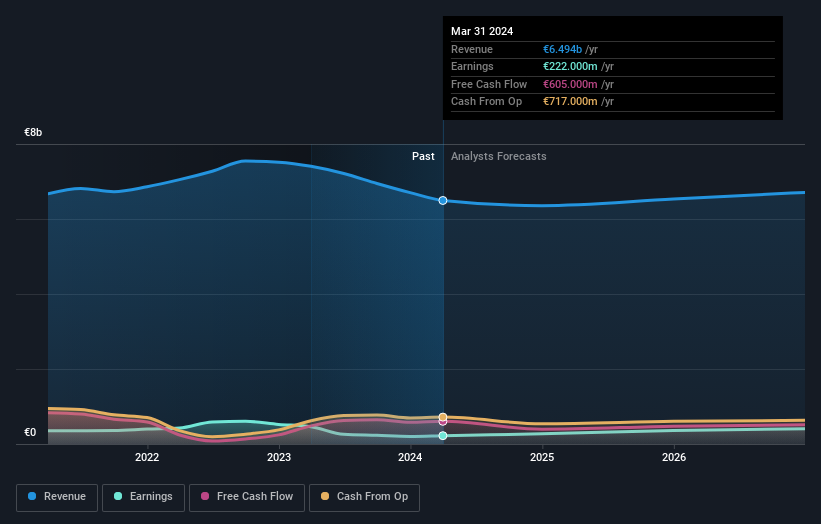- Netherlands
- /
- Electrical
- /
- ENXTAM:LIGHT
Signify N.V. (AMS:LIGHT) Just Reported First-Quarter Earnings: Have Analysts Changed Their Mind On The Stock?
Signify N.V. (AMS:LIGHT) shareholders are probably feeling a little disappointed, since its shares fell 8.8% to €25.76 in the week after its latest first-quarter results. The result was fairly weak overall, with revenues of €1.5b being 4.1% less than what the analysts had been modelling. This is an important time for investors, as they can track a company's performance in its report, look at what experts are forecasting for next year, and see if there has been any change to expectations for the business. With this in mind, we've gathered the latest statutory forecasts to see what the analysts are expecting for next year.
Check out our latest analysis for Signify

After the latest results, the consensus from Signify's eleven analysts is for revenues of €6.36b in 2024, which would reflect a perceptible 2.1% decline in revenue compared to the last year of performance. Statutory earnings per share are predicted to surge 21% to €2.13. Before this earnings report, the analysts had been forecasting revenues of €6.49b and earnings per share (EPS) of €2.21 in 2024. The analysts are less bullish than they were before these results, given the reduced revenue forecasts and the minor downgrade to earnings per share expectations.
Despite the cuts to forecast earnings, there was no real change to the €34.33 price target, showing that the analysts don't think the changes have a meaningful impact on its intrinsic value. That's not the only conclusion we can draw from this data however, as some investors also like to consider the spread in estimates when evaluating analyst price targets. The most optimistic Signify analyst has a price target of €44.00 per share, while the most pessimistic values it at €26.00. There are definitely some different views on the stock, but the range of estimates is not wide enough as to imply that the situation is unforecastable, in our view.
One way to get more context on these forecasts is to look at how they compare to both past performance, and how other companies in the same industry are performing. These estimates imply that revenue is expected to slow, with a forecast annualised decline of 2.8% by the end of 2024. This indicates a significant reduction from annual growth of 3.1% over the last five years. By contrast, our data suggests that other companies (with analyst coverage) in the same industry are forecast to see their revenue grow 6.4% annually for the foreseeable future. It's pretty clear that Signify's revenues are expected to perform substantially worse than the wider industry.
The Bottom Line
The biggest concern is that the analysts reduced their earnings per share estimates, suggesting business headwinds could lay ahead for Signify. On the negative side, they also downgraded their revenue estimates, and forecasts imply they will perform worse than the wider industry. The consensus price target held steady at €34.33, with the latest estimates not enough to have an impact on their price targets.
Keeping that in mind, we still think that the longer term trajectory of the business is much more important for investors to consider. We have forecasts for Signify going out to 2026, and you can see them free on our platform here.
And what about risks? Every company has them, and we've spotted 3 warning signs for Signify you should know about.
New: Manage All Your Stock Portfolios in One Place
We've created the ultimate portfolio companion for stock investors, and it's free.
• Connect an unlimited number of Portfolios and see your total in one currency
• Be alerted to new Warning Signs or Risks via email or mobile
• Track the Fair Value of your stocks
Have feedback on this article? Concerned about the content? Get in touch with us directly. Alternatively, email editorial-team (at) simplywallst.com.
This article by Simply Wall St is general in nature. We provide commentary based on historical data and analyst forecasts only using an unbiased methodology and our articles are not intended to be financial advice. It does not constitute a recommendation to buy or sell any stock, and does not take account of your objectives, or your financial situation. We aim to bring you long-term focused analysis driven by fundamental data. Note that our analysis may not factor in the latest price-sensitive company announcements or qualitative material. Simply Wall St has no position in any stocks mentioned.
About ENXTAM:LIGHT
Signify
Provides lighting products, systems, and services in Europe, the Americas, and internationally.
Undervalued with excellent balance sheet and pays a dividend.
Similar Companies
Market Insights
Community Narratives



